The 125-kilometer bus ride from Seoul to Gongju in Chungcheongnam Province is usually about 2 ½ hours long, but on this Thursday morning and afternoon it lasted almost six. The Chuseok holidays caused the roads to be packed. Gongju was not my destination, as I had been there in February 2010. I hopped on another bus and was deposited at a cluster of shops, restaurants and hotels whose sole purpose is to accommodate tourists of an old and historic Buddhist temple known as Magoksa.
Set on the side of a mountain with the pristine Taegeuk River flowing around in yin-yang fashion, it was founded in 640 by the monk Jajang Yulsa on land donated by Queen Seondeok. So many people came to hear his dharma talks that they resembled tightly packed hemp stalks, and thus the name “Magoksa.”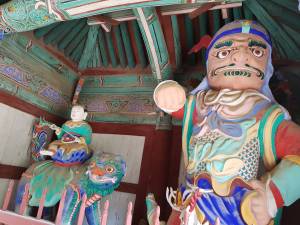 For two centuries after the turbulent transition from the Goryeo to the Joseon dynasty, Magoksa was literally a den of thieves. They were finally pushed out and the place re-consecrated. The story that really interested me, however, is of more recent vintage. It has to do with Korean nationalist Kim Gu. He killed a Japanese man suspected of having taken part in the 1895 murder of Empress Myeongseong at Gyeongbok Palace. Captured and tossed into Incheon Prison, he managed to escape and make his way to Magoksa. He shaved his head, put on a gray robe, took a Buddhist name and lived the monastic life before leaving and resuming his political activities. The juniper tree in front of Daegwangbojeon Hall was supposedly planted by Kim.
For two centuries after the turbulent transition from the Goryeo to the Joseon dynasty, Magoksa was literally a den of thieves. They were finally pushed out and the place re-consecrated. The story that really interested me, however, is of more recent vintage. It has to do with Korean nationalist Kim Gu. He killed a Japanese man suspected of having taken part in the 1895 murder of Empress Myeongseong at Gyeongbok Palace. Captured and tossed into Incheon Prison, he managed to escape and make his way to Magoksa. He shaved his head, put on a gray robe, took a Buddhist name and lived the monastic life before leaving and resuming his political activities. The juniper tree in front of Daegwangbojeon Hall was supposedly planted by Kim.
During my visit, I met a nun who called herself Su-nim. Although she was quite busy, she gave me nearly 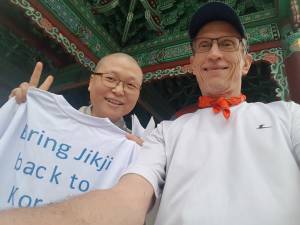 30 minutes of her time. We talked about Kim, the history of Magoksa, my Jikji campaign and temple stay. This is where secular people come for a day, a week or longer to learn about the Buddha’s teachings, adhere to a strict vegetarian diet (meals are eaten in silence), take a temporary vow of celibacy, get up at 4 a.m. and go to bed at 9 p.m., do communal chores and seek enlightenment by means such as pondering a blade of grass. Su-min initially thought I had come to partake in temple stay, but no. All the time we talked, a monk was chanting sutras and mantras, and beating on a hollow drum.
30 minutes of her time. We talked about Kim, the history of Magoksa, my Jikji campaign and temple stay. This is where secular people come for a day, a week or longer to learn about the Buddha’s teachings, adhere to a strict vegetarian diet (meals are eaten in silence), take a temporary vow of celibacy, get up at 4 a.m. and go to bed at 9 p.m., do communal chores and seek enlightenment by means such as pondering a blade of grass. Su-min initially thought I had come to partake in temple stay, but no. All the time we talked, a monk was chanting sutras and mantras, and beating on a hollow drum.
On my way out, I passed through the Deva King Gate. Inside it stood four beings whose jobs were to guard Buddhism from north, south, east and west. The bodhisattva of wisdom rode a blue tiger, the bodhisattva of power rode a white elephant, and the other two were big and ferocious in a funny sort of way.
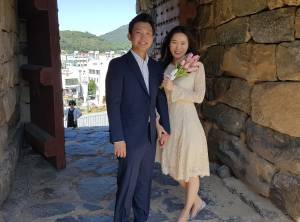 The next morning, I learned that I could not go directly to Hapdeok 35 kilometers to the northwest. I had no choice but to take a bus down to Gongju, then another up to Dangjin and from thence to Hapdeok. I had a 3 ½-hour layover in Gongju, so I used it by crossing a steel bridge (a part of which had been destroyed on July 12, 1950 by American soldiers seeking to slow down the North Korean enemy) over the Geum River to Gongju Fortress. While there, I encountered an attractive young couple having photos taken in advance of their wedding. They gave their permission for me to take one myself.
The next morning, I learned that I could not go directly to Hapdeok 35 kilometers to the northwest. I had no choice but to take a bus down to Gongju, then another up to Dangjin and from thence to Hapdeok. I had a 3 ½-hour layover in Gongju, so I used it by crossing a steel bridge (a part of which had been destroyed on July 12, 1950 by American soldiers seeking to slow down the North Korean enemy) over the Geum River to Gongju Fortress. While there, I encountered an attractive young couple having photos taken in advance of their wedding. They gave their permission for me to take one myself.
I got to Dangjin in mid-afternoon. No matter how hard I tried, I could not remember a thing about my visit there in March 2011. Fortunately, there was no delay in making the rather short trip to Hapdeok. I arrived and found a hotel across the street from the bus terminal; my room, quite curiously, was equipped with a dog-eared phone book from 2007!
Hapdeok is the epicenter of the region once called Naepo, where one wave of religious persecution after another occurred during the late Joseon period. It reached a horrific nadir in 1866 when some 8,000 Korean Christians and nine French priests suffered death. The ruling neo-Confucians found the new faith threatening and were determined to do all they could to stamp it out. The most famous of these martyrs was Kim Tae-gon, the first native Korean Catholic priest. Kim was arrested, sent to Seoul and killed at Saenamteo on the north bank of the Han River. I took a taxi to Solmoe, Kim’s restored birth home, now set in a peaceful grove of pine trees. Yet another taxi took me to Hapdeok Catholic Church, a 90-year-old Gothic-style brick edifice. Its predecessor was built there to honor the many Christians who had lost their lives (but—they firmly believed—gained eternity) at that spot. It was a veritable killing field in 1866.
With two hours of daylight left, I was determined to reach Hapdeok’s third holy place—Shinri. Home to more than 400 devotees in those trying years, it was one of the largest Christian communities in the 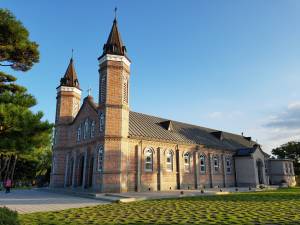 country. Shinri was almost entirely wiped out by order of Heungseon Daewongun, Korea’s de facto ruler. Today, it holds many relics pertaining to the lives of Kim, Won Si-jang, Won Si-bo, Yi Bo-hyeon and other martyrs. The names of yangbans were written down, but no such respect was shown to the far more numerous commoners. I met a young woman living nearby and asked her to call a taxi so I could get to Shinri. Lee Su-bin was her name. She discussed it with her boyfriend and mother, and then as I’d hoped, offered to take me herself. The four of us drove five kilometers south. I thanked them profusely and went to explore the place. Unfortunately, its museum was closed due to Chuseok. Still, I was able to learn more gruesome and heartbreaking history.
country. Shinri was almost entirely wiped out by order of Heungseon Daewongun, Korea’s de facto ruler. Today, it holds many relics pertaining to the lives of Kim, Won Si-jang, Won Si-bo, Yi Bo-hyeon and other martyrs. The names of yangbans were written down, but no such respect was shown to the far more numerous commoners. I met a young woman living nearby and asked her to call a taxi so I could get to Shinri. Lee Su-bin was her name. She discussed it with her boyfriend and mother, and then as I’d hoped, offered to take me herself. The four of us drove five kilometers south. I thanked them profusely and went to explore the place. Unfortunately, its museum was closed due to Chuseok. Still, I was able to learn more gruesome and heartbreaking history.
I went out on the road adjoining Shinri. It was a remote area, and I wondered how I could effectuate a return to town. To my relief, almost immediately a taxi with a red light indicating availability came motoring along. Back in Hapdeok, I found a pizza restaurant open and willing to serve a lonely foreigner. I had dinner there and read 30 pages of a biography about playwright Tennessee Williams (Glass Menagerie, Cat on a Hot Tin Roof, Streetcar Named Desire, etc.).
The next morning, I walked the streets of this shrinking and economically challenged town. I was distressed to see so many empty storefronts; in many cases, the owner did not even bother 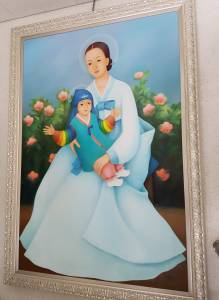 to put up an im dae (“for rent”) sign. I went into a sauna, passed a soothing hour there and checked out of my hotel. Back in Seoul, I was at Nambu Bus Terminal when I saw a lady with a heavy suitcase struggling to get it up two flights of stairs. I was pleased to help her.
to put up an im dae (“for rent”) sign. I went into a sauna, passed a soothing hour there and checked out of my hotel. Back in Seoul, I was at Nambu Bus Terminal when I saw a lady with a heavy suitcase struggling to get it up two flights of stairs. I was pleased to help her.
My adventure in the northwest corner of South Chungcheong Province was over. On Sunday, however, I went with my friend Audrey Lim to Saenamteo. Used as a military training ground hundreds of years ago, it later became an execution site for treasonous criminals and finally for Christian martyrs. Here, on September 16, 1846, Kim Tae-gon (renamed St. Andrew 138 years later by Pope John Paul II) was tortured and beheaded at the age of 25. Right next door is a large hanok-style building, the Saenamteo Catholic Holy Place of the Martyrs where the remains of several other believers who willingly shed their blood for the faith are enshrined.

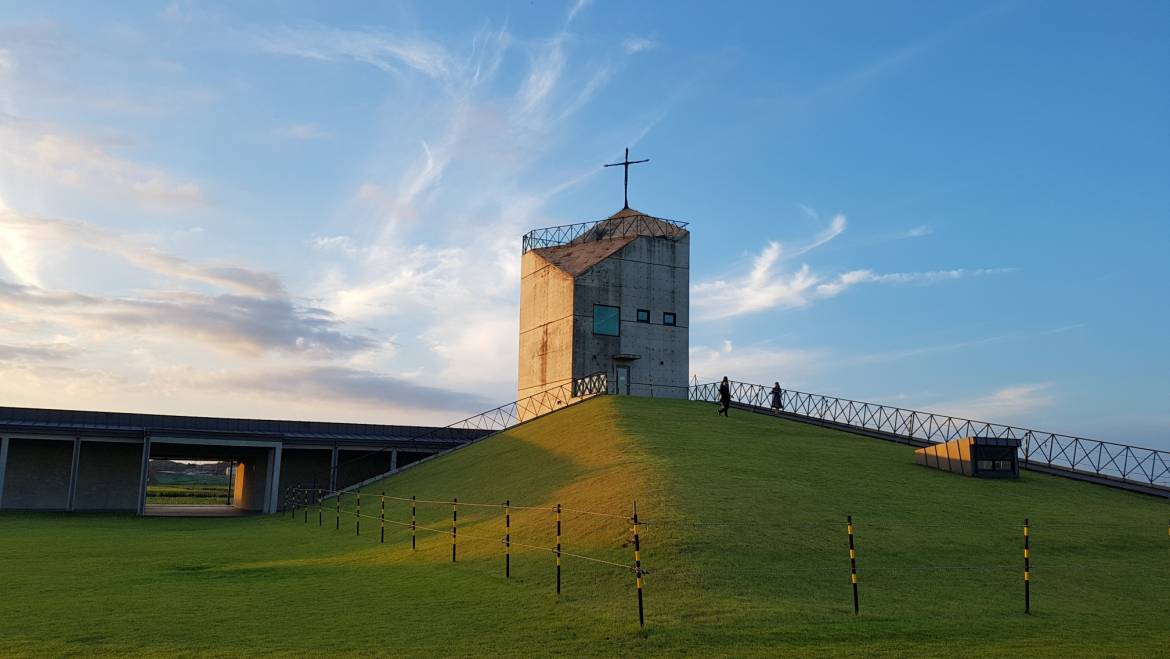
6 Comments
Another well written history lesson! I learn so much in your writing about the struggles of the Koreans. So many people have lost their lives to bring us Christianity!
Thanks, Denise. Yes, many suffered in the process of bringing the faith here. I admire them so much!
Your viewpoint of history in this province is both intriguing and enlightening. I a, always amazed at the encounters and of the stories involving your travels where people help you with directions and even a ride.
I can tell you, I feel greatly blessed to be able to undertake these travels in South Korea.
Richard:
Thanks for including me on your cc list. Your essays are outstanding with great detail and research. The big question is who will win this year’s Red River Shootout!
Rex
Rex, is that really the big question?
Add Comment